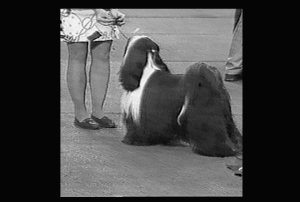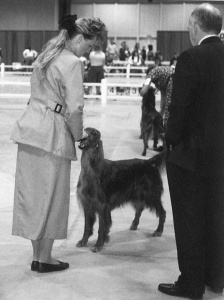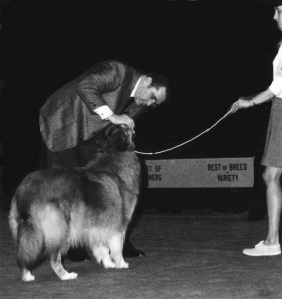 Baiting could be considered an art form for those who sit on the sidelines of the show ring. Done right, it can be difficult to spot when the dog is being fed bait, creating a more pleasurable picture. Baiting should be a deliberately subtle and tantalizing reward for the well-mannered show dog. In this way, the handler can keep the dog’s interest and attention focused on him, and the dog more easily maintains an alert posture that helps show off his best attributes.
Baiting could be considered an art form for those who sit on the sidelines of the show ring. Done right, it can be difficult to spot when the dog is being fed bait, creating a more pleasurable picture. Baiting should be a deliberately subtle and tantalizing reward for the well-mannered show dog. In this way, the handler can keep the dog’s interest and attention focused on him, and the dog more easily maintains an alert posture that helps show off his best attributes.
Baiting rewards should only be given to the dog whose four feet are firmly planted on the ground and who has his attention focused on the handler. The dog should also be alert, but not overly excited. One of the biggest faux pax in the show ring is allowing your dog to vacuum up bait dropped by other dogs or handlers. Never let your dog sniff or eat bait that is dropped in the ring.
Small, soft and easily eaten and swallowed pieces should be used. A dog chewing a large chunk of bait does not make a pretty impression on the judge, as well as may distract other dogs around them. Little pieces broken off from liver cake or cooked or dehydrated liver is most often used. Before you enter the ring, preferably when you start training for the show ring, find out what really excites your dog and feed him that only when being trained for show or when he is in the ring. If you keep the bait a really special, high-dollar treat, the dog will respond better than if it is old, boring blah food. Some people find that their dogs bait better if they have fasted for thirty-six hours before show time. A dog that has just eaten will not be as highly attentive or interested in the bait that you give him in the ring.
Hold the bait steady. Don’t wave it around as than the dog will follow where it goes and will not look his best, even potentially looking like a marionette with the strings loose or broken, with his head bobbing up and down or to the sides. Keep in mind that if he moves his head too much, it will affect his balance and throw off his show stack. With a medium-sized dog, most average height handlers can hold the bait at about waist high, just a little over eye level for the dog. If the dog is on the table, this height may also be appropriate, depending on the size of the dog. Hold the bait in one hand, with a piece or two closer to your fingers to easily and quickly dispense when the dog is holding a proper position. Keep your hand close to your body as much as possible. Don’t distract the attention of the judge from your dog.
Be very careful of having the bait too high or too low. Too high he will tend to point his muzzle up, shortening his neck on top and very possibly hollowing his back and creating the wrong angles for his shoulders. Too low and his neck will stretch out as his nose moves downward, creating an image of a low neck and shoulders angled incorrectly. This may also distort his actual topline as he lowers himself to reach the bait.
Young, rowdy dogs should not be allowed to lunge or grab at the bait. They should learn their manners at home before entering the show ring.
If possible, practice in front of a mirror, or better yet, videotape it so that you can review how your dog reacts to where you have the bait, if he is standing correctly and if you are timing giving the bait right or not.
While in the ring, always be aware of where the judge is and what is going on. Make sure to quickly and smoothly move your dog up to the predetermined judging area and prepare him for his examination. Use your bait judiciously. You want his attention, alert expression and a sharp eye. It is acceptable to bait the dog while waiting for the judge to arrive to examine your dog. Step away to allow the judge to look over your dog to show that you have confidence in your dog and give him room to work. Do not continue baiting again until the judge has finished examining the front and shoulders.
With consistent practice you should be able to present a beautiful piece of art, your dog, effortlessly and smoothly.
Learn more about handling your dog for the show ring in Peter Green and Mario Migliorini’s book, New Secrets of Successful Show Dog Handling.





